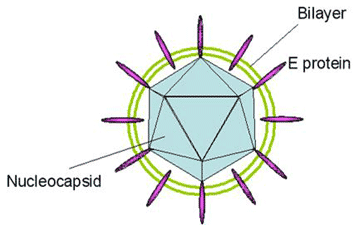Bloodborne Pathogens
Hepatitis C Virus (HCV)

Structure of Hepatitis C Virus
The Hepatitis C virus (HCV) is a major cause of acute hepatitis and chronic liver disease, including cirrhosis and liver cancer. According to estimates from the Centers for Disease Control and Prevention, an estimated 3.9 million Americans (1.8%) have been infected with HCV, and 2.7 million are chronically infected. The number of new infections per year has declined from an average of 240,000 in the 1980s to about 30,000 in 2003. Illegal injection drug use is the primary cause of infection.
Approximately 80% of the persons infected with Hepatitis C have no signs or symptoms. Those that have symptoms and signs may exhibit the following:
- Jaundice
- Fatigue
- Dark Urine
- Abdominal Pain
- Loss of Appetite
- Nausea
Chronic infections occur in 75-85% of infected persons, and chronic liver disease occurs in 70% of infected persons. There is no vaccine for Hepatitis C.
For more information on Hepatitis C, see the Centers for Disease Control and Prevention's (CDC) fact sheet on Hepatitis C. (link will open a new browser window or tab)
